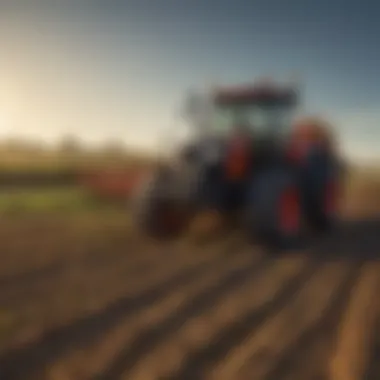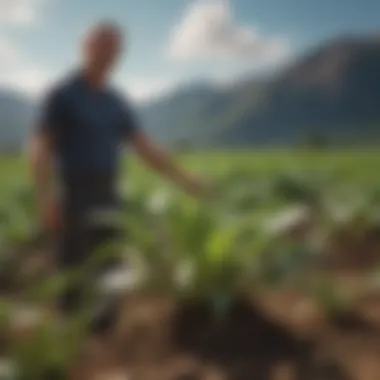Understanding Captan Seed Treatment in Agriculture


Intro
Captan is a fungicide that plays a crucial role in seed treatment within agricultural practices. Understanding its implications and applications is essential for farmers and agricultural enthusiasts. This section aims to provide a solid foundation for why Captan is crucial in seed treatment and its broader impact on farming.
Captan works primarily by inhibiting the growth of fungi that can attack seeds, thus protecting crops at their most vulnerable stage. Such protection can lead to healthier plants and improve yields, making it a valuable asset in modern agriculture.
This article will unfold the significance of Captan by exploring its chemical properties, application methods, and its environmental implications. Whether you are a farmer, a researcher, or simply interested in agriculture, understanding Captan's role will enrich your knowledge of sustainable practices and crop management.
Latest Trends in Agriculture
Overview of Current Trends
Agriculture is continuously evolving, and understanding the trends can help farmers adapt to new challenges. Recent years have seen a shift towards more sustainable practices and the incorporation of technology. Captan as a seed treatment reflects these changes, as farmers seek effective solutions that also consider environmental impacts.
Impact of Technology on Farming Practices
Technology has revolutionized farming practices. The integration of precision agriculture tools allows farmers to apply treatments like Captan more efficiently. This minimizes waste and enhances efficacy. Drones, for instance, can aid in monitoring crop health, enabling timely treatments with Captan when needed. Ensuring that technology complements traditional methods is critical for future farming success.
Sustainable Practices: Towards a Greener Future
Importance of Sustainability in Agriculture
Sustainability in agriculture helps preserve our resources for future generations. It also promotes biodiversity, protects ecosystems, and fosters soil health. While Captan can be effective in protecting crops from disease, it is also essential to use it responsibly. Understanding the impact of chemical treatments on the environment is part of sustainable agriculture.
Methods for Sustainable Farming
To achieve sustainability, farmers can implement various methods, such as:
- Using organic fertilizers and cover crops to enhance soil fertility.
- Rotating crops to prevent disease build-up.
- Minimizing chemical inputs, utilizing them only when justified. In adopting these practices, Captan can be part of a larger strategy that embraces both productivity and ecological responsibility.
Gardening Techniques and Tips
Essential Gardening Tools and Equipment
For those involved in gardening, the right tools make a difference. Key equipment includes:
- Trowels for planting and cultivating soil.
- Pruners for maintaining plant health.
- Sprayers for applying treatments like Captan effectively.
Seasonal Gardening Practices
Seasonal changes dictate different gardening practices. Early spring is ideal for applying treatments like Captan to seeds before planting. Understanding timing is crucial for effective crop success.
"Captan seed treatment is not just a matter of choice; it is a key component of modern farming that addresses both productivity and sustainability."
Preface to Captan
Captan is a critical component in modern agriculture, specifically in seed treatment. Its role extends beyond simple protection against pathogens; it enhances the overall health of crops, affecting their robustness and yield. Understanding Captan involves exploring its chemical composition, functionality, and the historical context that led to its prevalent use. Farmers and agricultural professionals benefit significantly from this knowledge, as it allows for informed decisions regarding seed treatments and crop management strategies.
Chemical Composition and Functionality
Captan is a compound made from a blend of specific chemicals that play various roles in preventing fungal infections in seeds. The primary active ingredient, N-trichloromethylthio-phthalimide, effectively inhibits fungal growth by disrupting cellular respiration processes in pathogens. This mechanism is essential for protecting seeds against diseases early in their growth cycle. Furthermore, Captan's broad-spectrum action means it can combat a wide array of fungi, making it indispensable for various crops.
Beyond its function as a fungicide, Captan also contributes to improved seed germination and plant growth. By creating a protective barrier around seeds, it facilitates the absorption of moisture and essential nutrients, leading to stronger initial development. This consequent vigor is crucial for ensuring that plants are less susceptible to stressors later on in their life cycles.
Historical Context and Development
The advent of Captan in agricultural practices can be traced back to the early 20th century. Initially developed as a product for agricultural use, it emerged during a time when the need for effective crop protection was becoming increasingly urgent due to rising incidences of fungal diseases. Since then, Captan has undergone numerous evaluations and reforms to enhance its efficacy and safety for both crops and humans.


Over the years, researchers continuously examined its effectiveness against various pathogens. These studies have shaped the guidelines on optimal usage and application methods. Today, Captan is recognized not only for its fungicidal abilities but also for its relatively low toxicity; compared to some alternative treatments, Captan presents a more favorable profile for use in agricultural settings. Its historical evolution highlights the balance between efficacy and safety, underscoring its importance in sustainable agriculture.
"Captan’s historical development reflects both the challenges of managing fungal diseases and advancements in agricultural chemistry."
Understanding this context provides agricultural professionals with clearer insights into why Captan is so widely adopted in seed treatments. It bridges the gap between past pest management practices and the methods used today, ensuring that we grasp its vital role in enhancing agricultural productivity.
Mechanisms of Action
Understanding the mechanisms of action for Captan is critical for grasping its role in seed treatment. By recognizing how Captan functions, agricultural practitioners can optimize its use, maximize crop yield, and promote sustainable practices. The efficacy of Captan lies in its chemical properties, which are tailored for fungicidal activity, making it a valuable asset in thwarting seed-borne diseases that hinder agricultural productivity.
Fungicidal Properties
Captan is categorized as a broad-spectrum fungicide. Its primary mode of action revolves around the inhibition of spore germination and the prevention of fungal mycelial growth. When applied to seeds, Captan forms a protective barrier that is instrumental in safeguarding against fungal pathogens.
- Chemical Reactions: Captan interacts with various cellular components of fungi, disrupting metabolic processes essential for growth.
- Prevention of Diseases: By targeting pathogens at an early stage, Captan minimizes the likelihood of seedling diseases, thus ensuring a healthier start for crops.
In essence, its fungicidal properties serve as a frontline defense mechanism that enhances the viability of seeds during the critical germination phase. This proactive approach is essential given the increasing concerns regarding crop diseases in contemporary agriculture.
Effect on Seed Pathogens
The effectiveness of Captan is closely linked to its role in combating seed pathogens. These pathogens, often responsible for significant agricultural losses, can severely impede crop yield and quality. Captan's function against these threats is multifaceted and noteworthy.
- Target Spectrum: Captan is effective against a wide range of seed-borne fungi, including but not limited to, Fusarium and Alternaria species. This broad spectrum is important in regions where diverse diseases may prevail.
- Synergistic Effects: When used in conjunction with other treatment methods, Captan enhances overall disease management strategies. This synergy can lead to improved resistance and reduced reliance on chemical treatments in the long term.
"The integration of Captan into seed treatment protocols is essential for sustainable agricultural practices and provides a robust defense against common seed pathogens."
The strategic application of Captan, therefore, not only protects the seed but also ensures a higher germination success rate, paving the way for healthy crop development and increased agricultural productivity.
Application Methods
Understanding the application methods of Captan is crucial for maximizing its effectiveness in seed treatment. Various methods alter the outcomes of seed health and crop performance. Emphasizing correct application is fundamental for achieving desired fungicidal properties while minimizing potential environmental impacts. Key elements to consider include
- Seed Coating Techniques
- Timing and Dosage
These factors not only dictate the immediate efficacy of Captan, but also influence its long-term impact on seedlings and the surrounding ecosystem.
Seed Coating Techniques
Seed coating represents a primary method for applying Captan. This technique enhances adherence to the seed surface, ensuring more uniform distribution of the fungicide. Different materials may be used in coatings, such as polymers or natural substances, to facilitate effective fungicide delivery.
Using Captan for seed coating can lead to improved resistance against pathogens that threaten seedling development. Furthermore, the coating can assist in creating a micro-environment that stabilizes moisture and nutrients for the seedlings. However, care must be taken during the process.
- Type of Coating: The choice between a liquid or dry coating can affect coverage and effectiveness.
- Coating Thickness: Adequate thickness is required to avoid compromising seed viability or germination.
- Application Equipment: The right machinery can enhance uniformity and coat absorption.
These considerations are paramount to ensure the coating protects seeds without impeding their natural growth.
Timing and Dosage
The timing of Captan application is as critical as the methods used. Applying the fungicide at the right growth stage significantly influences seed germination and subsequent plant health. There are generally accepted guidelines about applying before planting, ensuring maximum effectiveness.
Dosage plays a vital role in the overall success of the treatment. A too low concentration may not provide sufficient protection, whereas a higher dosage risks toxicity to the seeds. Key points include:
- Pre-Planting Treatment: Ideal for maximizing seed protection during germination.
- Concentration Levels: Determined by seed type and expected pathogen threat levels.
Adjustments based on crop variety and soil conditions may be necessary. Understanding the balance of application timing and dosage can optimize the potential benefits of Captan seed treatment, driving efficiency in agricultural practices.
"Effective seed treatment requires careful consideration of coating methods and application timing to achieve desired outcomes in crop health."


In summary, the application methods of Captan are integral to its performance as a seed treatment. The success hinges on how seeds are coated and when the application occurs, influencing the results in agricultural productivity.
Benefits of Captan Seed Treatment
The application of Captan as a seed treatment offers multiple advantages that influence both short-term crop performance and long-term agricultural sustainability. Farmers and agricultural practitioners increasingly recognize its efficacy, supporting healthier planting and maximal resource use efficiency. The benefits of Captan seed treatment are not just limited to the initial growth stages but extend throughout the entire plant lifecycle. This section will explore key benefits such as increased germination rates, enhanced root development, and improved crop yield.
Increased Germination Rates
One of the prominent benefits of Captan seed treatment is the noticeable increase in germination rates among various crops. Captan functions by providing a protective barrier against seed-borne fungal pathogens. When seeds are treated with Captan, they have a higher chance of sprouting successfully, maximizing their potential at the very beginning of the growth cycle. This increased germination rate not only allows for more uniform crop emergence but also improves the overall vigor of seedlings.
Moreover, the application of Captan addresses issues related to soilborne diseases that can hinder seedling emergence. It acts on common pathogens like Fusarium and Rhizoctonia, significantly reducing their presence in the soil. Empirical studies have shown that treated seeds tend to germinate faster, providing farmers with options for earlier planting and potentially longer growing seasons.
Enhanced Root Development
Captan not only aids the germination process but also promotes robust root development. Well-developed root systems are crucial for the absorption of nutrients and water from the soil. When seeds are treated with Captan, they tend to establish stronger roots. A healthy root structure directly correlates with improved plant stability and resilience to environmental stresses, such as drought or nutrient deficiency.
Issues like root rot are substantially minimized due to the protective mechanism of Captan. Better root health enables plants to reach deeper soil layers, tapping into moisture reserves that unprotected plants may miss. Farmers often observe that crops treated with Captan are better equipped to withstand adverse weather conditions and maintain productivity.
Improved Crop Yield
The overarching benefit of Captan seed treatment culminates in improved crop yield. When seeds germinate effectively and develop strong root systems, the resultant plants exhibit higher resilience and productivity. A systematic review of various agricultural practices indicates that treated crops often showcase yield enhancements due to lower disease pressure and better resource utilization. The healthy progression from seedling to maturity facilitates a maximization of output.
Furthermore, crops such as corn, soybeans, and wheat exhibit marked improvements in yield following Captan treatment. This is vital for farmers looking to enhance profitability in an agricultural landscape where margins are increasingly narrow. Implementing Captan as part of an integrated pest management strategy can lead to sustainable farming practices, ensuring that farmers meet market demands without compromising the environment.
"Captan seed treatment is crucial for effective management of crop diseases, enhancing not just germination but productivity"
At the core, Captan seed treatment stands out as a strategic choice for farmers aiming for efficiency and sustainability in their agricultural operations. The benefits extend beyond immediate gains, promoting a healthier, more productive field environment that can serve agricultural needs for years to come.
Environmental Considerations
Understanding the environmental implications of Captan seed treatment is critical for sustainable agricultural practices. While Captan offers several benefits for seed protection, its ecological footprint must also be evaluated. This section explores key elements such as ecotoxicological effects and regulatory standards that stakeholders should consider when utilizing Captan in their farming operations.
Ecotoxicological Effects
Ecotoxicology examines the impact of toxic substances on ecosystems. Captan, as a fungicide, presents certain risks to non-target organisms, including soil microbes, insects, and aquatic ecosystems. Studies have shown varying degrees of sensitivity among different species.
- Soil Microorganisms: Captan can disrupt soil microbial communities essential for nutrient cycling and soil health. Its application may lead to a decline in beneficial bacteria, affecting organic matter decomposition and biological activity.
- Aquatic Life: When runoff occurs, Captan can enter water systems, posing threats to fish and other aquatic organisms. Research indicates potential bioaccumulation, raising concerns about long-term effects on food chains.
- Pollinators: The effects on pollinators, particularly bees, are a growing area of concern. While direct toxicity to bees is minimal, indirect effects through altered floral resources can impact bee health and behavior.
In summary, the application of Captan must be managed carefully to mitigate unintended harm to ecosystems. Awareness and adherence to best practices can greatly reduce the ecological risks associated with its use.
Regulatory Standards and Compliance
Regulatory frameworks guide the safe application of pesticides, including Captan. Compliance ensures that agricultural practices align with national and international standards, supporting both farmer health and environmental protection.
- Registration and Approval: In many countries, Captan must be registered with relevant authorities, such as the Environmental Protection Agency (EPA) in the United States. This process evaluates safety, efficacy, and potential risks before allowing market access.
- Label Instructions: Farmers must adhere to the instructions provided on the product label, which includes dosage recommendations, application timing, and safety precautions. Following these guidelines is essential to prevent misuse and environmental contamination.
- Monitoring and Reporting: Regulatory entities often require reporting on pesticide use and its impacts. This data helps track trends and informs future regulations, ensuring that captan use remains sustainable.
- Sustainability Certifications: Farmers seeking certifications for sustainable practices may need to provide evidence of compliance with environmental regulations, including the responsible use of Captan. Certifications can enhance marketability and consumer trust.
Challenges in Captan Use
Captan seed treatment has become a prominent method in agricultural practices, yet it is not without its challenges. Understanding these issues is crucial for stakeholders aiming for sustainable and effective use of this fungicide. Among the concerns surrounding Captan are resistance development in pathogens and the safety measures necessary for users handling the product. Each of these areas presents unique implications for agricultural effectiveness and safety.
Resistance Development in Pathogens
One of the primary challenges in the use of Captan is the potential for resistance development among pathogens. As with many fungicides, continuous application can lead to the selection of resistant strains of fungi. This can significantly diminish the effectiveness of Captan over time, resulting in poor disease control in crops. Factors contributing to this resistance include improper application techniques, inadequate dosages, and the repeated use of Captan without alternate fungicidal options.
In order to combat this issue, agronomists recommend integrating Captan with other fungicides that work through different mechanisms of action. This rotation strategy not only helps in managing resistance but also enhances overall disease prevention.
User Safety and Handling Practices


The safe handling and application of Captan are critical to minimizing health risks to users and ensuring environmental safety. Captan can be harmful if not properly managed, leading to skin irritation and respiratory discomfort. As such, farmers and agricultural workers must adhere to strict safety protocols when using this fungicide.
Key safety practices include:
- Wearing protective gear such as masks, gloves, and goggles.
- Training users on proper handling techniques to prevent accidents.
- Following label instructions precisely to ensure appropriate dosages and application methods.
By implementing stringent safety measures, users can mitigate the risks associated with Captan. It fosters a safer agricultural environment while maintaining the efficacy of seed treatments.
"Careful attention to both application techniques and user safety practices can enhance the benefits of using Captan while reducing potential hazards."
Comparative Analysis of Seed Treatments
In the field of agriculture, the choice of seed treatment is pivotal for ensuring successful crop establishment and yield. A comparative analysis of various seed treatments helps farmers and agricultural enthusiasts understand the merits and drawbacks of different options. This section highlights the implications of using Captan and places it within the broader context of available seed treatment alternatives. The findings can guide informed decisions regarding the most effective and sustainable practices.
Captan vs. Other Fungicides
Captan is widely regarded as an effective fungicide in seed treatment, but it is not the only option on the market. Comparing Captan with other fungicides, such as Thiram and Benomyl, reveals critical differences in efficacy, application, and environmental impact.
- Efficacy: Captan exhibits a broad spectrum of activity against various soil-borne and seed-borne fungi. In contrast, Thiram primarily targets specific fungal species. The broad action of Captan makes it a versatile choice, especially for crops prone to multiple pathogens.
- Application: Captan is applied as a protective agent but does not have systemic properties. This means it protects seeds from infection at the surface but may require timely application for maximum effectiveness. Other fungicides, like Benomyl, offer systemic action, providing protection once absorbed by the plant but may pose higher risks to human health and the environment.
- Environmental Impact: Ecological considerations play an essential role in the choice of seed treatments. Captan has been scrutinized due to potential effects on beneficial organisms in the soil. Research indicates that while it may negatively impact certain insect populations, its overall ecological footprint can be more manageable than other fungicides that are persistently harmful.
By examining these factors, one can evaluate the suitability of Captan compared to alternative fungicides, considering both the immediate benefits for crop health and the long-term effects on the environment.
Integrative Approaches to Seed Treatment
The landscape of seed treatment is evolving, moving toward practices that combine various methods for improved outcomes. Integrative approaches to seed treatment not only encompass the application of products like Captan but also integrate cultural, biological, and chemical methods. This holistic perspective enhances pest and disease management strategies.
Key elements of integrative seed treatment include:
- Rotation of Treatments: Alternating fungicides can mitigate resistance development in pathogens. By not relying solely on Captan, farmers can preserve its effectiveness over time and ensure sustainable farming practices.
- Biological Controls: Incorporating biological agents such as Trichoderma species can complement chemical treatments. These beneficial fungi can suppress pathogens and enhance plant growth, reducing the reliance on synthetic chemicals like Captan.
- Soil Health: Emphasizing soil health through practices like cover cropping can improve the natural resistance of plants to diseases. Healthy soil fosters beneficial microbial communities, which can naturally protect crops from pathogens.
Adopting integrative approaches not only promotes effective disease management but also aligns with modern agricultural practices that prioritize sustainability and ecological harmony. Assessing current trends while implementing innovative solutions will continue to shape the future of seed treatments.
Research and Future Directions
Research into the applications and implications of Captan seed treatment in agriculture is crucial for advancing practices that enhance crop resilience and productivity. As agricultural challenges grow, especially in the context of climate change and pest resistance, innovative approaches to seed treatment are essential. Understanding current trends and exploring potential innovations not only supports sustainable farming but also fortifies food security globally.
Current Trends in Seed Treatment Research
Among the current trends, the focus is shifting towards the integration of seed treatment with precision agriculture technologies. This approach includes utilizing data analytics to determine the optimal timing and dosage of Captan application. By doing so, farmers can minimize chemical use while maximizing effectiveness against pathogens. Research also shows an emphasis on breeding crop varieties that are inherently more resistant to diseases, which can reduce reliance on fungicides like Captan.
Moreover, studies are investigating the synergistic effects of combining Captan with biocontrol agents, aiming for a more holistic approach to disease management. This combination may foster an environment where both chemical and ecological strategies work hand-in-hand, enhancing overall crop health. Another noteworthy trend involves the evaluation of Captan’s long-term effectiveness and safety in various environmental contexts, ensuring compliance with evolving regulatory standards.
Potential Innovations in Captan Applications
Future innovations in Captan applications may include the development of formulations that increase the chemical's stability and efficacy. For example, research is exploring nano-encapsulation techniques which could protect Captan from degradation, allowing for sustained release during key growth stages of the crop. This could significantly improve disease control over prolonged periods, reducing the frequency of applications needed.
In addition, advancements in smart delivery systems are on the horizon. These systems would enable targeted application of Captan, solely where and when it is needed based on real-time data from sensor networks in the field. Such technology could revolutionize how fungicides are utilized, decreasing potential environmental impacts while maintaining crop health.
Innovations in Captan seed treatment not only enhance agricultural efficiency but also contribute significantly to the sustainability of modern farming practices.
Furthermore, understanding the biological mechanisms of how Captan interacts with both pathogens and plant systems could open new avenues for its use. Biochemistry research has the potential to reveal precisely how Captan disrupts fungal lifecycle processes, paving the way for tailored applications that could further reduce required dosing.
The End
Captan seed treatment plays a pivotal role in modern agriculture, impacting seed viability and crop health. Understanding its comprehensive implications is essential for farmers and agricultural professionals in making informed decisions about crop management strategies.
Summary of Key Insights
In this article, we explored various facets of Captan seed treatment, including its chemical properties, mechanisms of action, and application methods. Key insights include the observation that Captan provides effective protection against several seed pathogens, thus enhancing germination rates and overall crop yield. Additionally, we discussed the importance of applying Captan correctly, paying attention to dosage and timing to optimize its benefits without compromising safety. Environmental considerations were also addressed, emphasizing the need to understand ecotoxicological effects and adhere to regulatory standards.
Final Thoughts on Captan in Modern Agriculture
As agriculture faces increasing challenges from pests and diseases, Captan remains a significant chemical tool in the agronomic arsenal. Its benefits in seed treatment, particularly in enhancing plant vigor and resilience, are vital for sustainable crop production. Nonetheless, users should navigate its application with care, always being mindful of the evolving landscape of resistance in pathogens and regulatory changes. In sum, while Captan presents numerous benefits, ongoing research and responsible usage are necessary to harness its full potential in modern agriculture.







